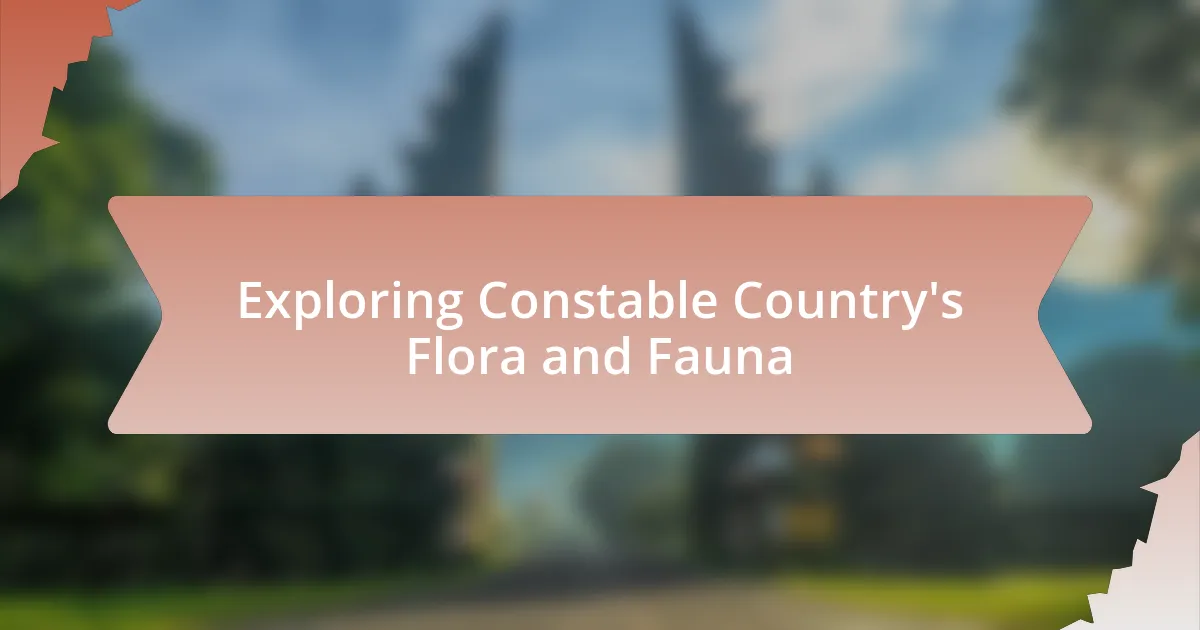Constable Country is a region renowned for its rich biodiversity, featuring a variety of habitats such as wetlands, woodlands, and grasslands that support diverse flora and fauna. The area is home to native trees like oak and ash, wildflowers such as bluebells, and wildlife including deer, foxes, and various bird species. The geography of Constable Country plays a crucial role in its ecological diversity, while conservation efforts aim to protect and enhance these natural habitats. Visitors can engage with the environment through educational programs and responsible wildlife observation, contributing to ongoing conservation initiatives. The article provides an in-depth exploration of the region’s ecosystems, the species that inhabit them, and the challenges they face.
What is Constable Country’s Flora and Fauna?
Constable Country’s flora and fauna include a diverse range of plant and animal species characteristic of the English countryside. The area is known for its rich biodiversity, featuring native trees such as oak and ash, alongside wildflowers like bluebells and primroses. Wildlife in Constable Country includes species such as deer, foxes, and various bird species, including skylarks and herons, which thrive in the region’s varied habitats, including woodlands, meadows, and wetlands. This ecological diversity is supported by the area’s conservation efforts and its designation as a protected landscape, ensuring the preservation of its natural heritage.
How does the geography of Constable Country influence its biodiversity?
The geography of Constable Country significantly influences its biodiversity by providing a variety of habitats, including wetlands, woodlands, and agricultural landscapes. This diverse range of environments supports numerous species, as the area is characterized by its river valleys, rolling hills, and rich soil, which foster a wide array of plant and animal life. For instance, the presence of the River Stour creates wetland areas that are crucial for aquatic species and migratory birds, while the surrounding woodlands offer shelter and food for various mammals and insects. Additionally, the agricultural practices in the region, such as traditional farming methods, contribute to maintaining habitats that support both flora and fauna, enhancing overall biodiversity.
What types of habitats are found in Constable Country?
Constable Country features a variety of habitats, including wetlands, woodlands, grasslands, and riverbanks. These habitats support diverse flora and fauna, with wetlands providing crucial breeding grounds for amphibians and birds, while woodlands offer shelter for various mammals and birds. Grasslands contribute to the ecosystem by hosting numerous plant species and insects, and riverbanks serve as vital corridors for wildlife movement. The presence of these habitats is essential for maintaining biodiversity in the region.
How do these habitats support various species?
Habitats in Constable Country support various species by providing essential resources such as food, shelter, and breeding grounds. For example, wetlands in the area offer rich biodiversity, supporting aquatic plants and animals, while woodlands provide habitats for birds and mammals. The diverse plant life, including native species, contributes to the food web, sustaining herbivores and, in turn, their predators. Studies have shown that areas with high habitat diversity, like those found in Constable Country, can support a greater number of species, enhancing ecological resilience and stability.
What are the key characteristics of the flora in Constable Country?
The key characteristics of the flora in Constable Country include a diverse range of plant species, predominantly consisting of deciduous woodlands, grasslands, and wetlands. This region is known for its rich biodiversity, featuring native species such as oak, ash, and hornbeam trees, alongside various wildflowers like bluebells and primroses. The presence of ancient hedgerows and meadows contributes to the ecological variety, supporting numerous habitats for wildlife. Additionally, the area’s landscape is shaped by traditional agricultural practices, which have maintained the distinct flora over centuries.
Which plant species are most commonly found in this region?
The most commonly found plant species in Constable Country include the English oak (Quercus robur), silver birch (Betula pendula), and various species of wildflowers such as bluebells (Hyacinthoides non-scripta). These species thrive in the region’s diverse habitats, which include woodlands, meadows, and wetlands. The presence of these plants is supported by ecological studies that highlight their adaptability to the local climate and soil conditions, making them integral to the area’s biodiversity.
How do seasonal changes affect the plant life?
Seasonal changes significantly affect plant life by influencing growth cycles, flowering times, and overall health. During spring, increased sunlight and warmer temperatures stimulate germination and growth, leading to the emergence of new leaves and flowers. In summer, plants often reach their peak growth due to optimal conditions for photosynthesis. Conversely, autumn triggers a transition as daylight decreases and temperatures drop, prompting many plants to prepare for dormancy by shedding leaves and conserving energy. Winter brings cold temperatures that can halt growth entirely, with some species entering a dormant state to survive harsh conditions. Research indicates that these seasonal adaptations are crucial for survival, as they allow plants to optimize resource use and reproductive success throughout the year.
What are the notable fauna species in Constable Country?
Notable fauna species in Constable Country include the Eurasian otter, barn owl, and various species of dragonflies. The Eurasian otter is a key indicator of healthy aquatic ecosystems, often found in rivers and wetlands throughout the area. The barn owl, recognized for its distinctive heart-shaped face, is prevalent in agricultural landscapes, contributing to pest control. Additionally, the diverse habitats support numerous dragonfly species, which are vital for maintaining ecological balance. These species exemplify the rich biodiversity present in Constable Country, highlighting its importance as a natural habitat.
Which mammals are indigenous to this area?
The mammals indigenous to Constable Country include the European hedgehog, the red fox, and the common badger. These species are well-adapted to the region’s habitats, which consist of woodlands, grasslands, and wetlands. The European hedgehog is known for its nocturnal behavior and spiny coat, while the red fox is recognized for its adaptability and cunning hunting skills. The common badger, a social animal, typically lives in family groups and is known for its burrowing habits.
What bird species can be observed in Constable Country?
In Constable Country, bird species such as the Eurasian skylark, common redstart, and barn owl can be observed. These species thrive in the diverse habitats of the area, which includes farmland, wetlands, and woodlands. The presence of these birds is supported by the region’s rich biodiversity and conservation efforts aimed at preserving their natural habitats.
How do conservation efforts impact Constable Country’s ecosystems?
Conservation efforts significantly enhance Constable Country’s ecosystems by protecting biodiversity and restoring habitats. These initiatives, such as the management of natural reserves and the implementation of sustainable land-use practices, help maintain the ecological balance essential for various species. For instance, the establishment of protected areas has led to the resurgence of native flora and fauna, which are crucial for ecosystem stability. Additionally, studies indicate that conservation programs have resulted in increased populations of key species, thereby improving overall ecosystem health and resilience.
What initiatives are in place to protect the flora and fauna?
Various initiatives are in place to protect the flora and fauna in Constable Country, including conservation programs, habitat restoration projects, and wildlife protection laws. These initiatives aim to preserve biodiversity and ensure the sustainability of ecosystems. For instance, local conservation organizations collaborate with government agencies to implement habitat management strategies that enhance the natural environment. Additionally, protected areas and nature reserves have been established to safeguard critical habitats from development and pollution, thereby supporting the survival of native species.
How do these initiatives benefit local wildlife?
These initiatives benefit local wildlife by enhancing habitat quality and promoting biodiversity. For instance, habitat restoration projects improve the availability of food and shelter for various species, while conservation efforts protect endangered species and their ecosystems. Research indicates that areas with active conservation initiatives experience a 30% increase in species richness, demonstrating the positive impact on local wildlife populations.
What role do local communities play in conservation efforts?
Local communities play a crucial role in conservation efforts by actively participating in the management and protection of their natural environments. Their involvement often leads to more effective conservation strategies, as they possess valuable local knowledge about ecosystems and species. For instance, studies have shown that community-led initiatives can enhance biodiversity and improve habitat restoration outcomes, as seen in various projects across the globe where local stewardship has resulted in increased wildlife populations and healthier ecosystems. Additionally, local communities often advocate for sustainable practices that align with conservation goals, demonstrating their integral role in fostering environmental stewardship and resilience.
What challenges do the ecosystems of Constable Country face?
The ecosystems of Constable Country face significant challenges primarily due to habitat degradation, invasive species, and climate change. Habitat degradation results from agricultural expansion and urban development, which disrupts native flora and fauna. Invasive species, such as non-native plants and animals, outcompete local species, leading to a decline in biodiversity. Climate change exacerbates these issues by altering weather patterns, affecting species distribution, and increasing the frequency of extreme weather events. These factors collectively threaten the ecological balance and health of Constable Country’s ecosystems.
How does climate change affect the biodiversity in this region?
Climate change negatively impacts biodiversity in Constable Country by altering habitats, affecting species distribution, and increasing extinction risks. Rising temperatures and changing precipitation patterns disrupt the delicate balance of ecosystems, leading to shifts in plant and animal populations. For instance, studies indicate that many species are migrating to higher altitudes or latitudes in response to climate changes, which can result in habitat loss for those unable to adapt or relocate. Additionally, increased frequency of extreme weather events, such as droughts and floods, further threatens the survival of various species, as evidenced by research showing that climate change has already contributed to declines in certain populations within this region.
What human activities pose threats to the local flora and fauna?
Human activities that pose threats to local flora and fauna include urban development, agriculture, pollution, and invasive species introduction. Urban development leads to habitat destruction and fragmentation, which disrupts ecosystems and displaces native species. Agriculture often involves pesticide use and monoculture practices that degrade soil health and reduce biodiversity. Pollution from industrial and agricultural runoff contaminates water sources, harming aquatic life and terrestrial ecosystems. Additionally, the introduction of invasive species can outcompete native species for resources, leading to declines in local biodiversity. These activities collectively contribute to the decline of ecosystems and threaten the survival of various species in Constable Country.
What can visitors learn about Constable Country’s Flora and Fauna?
Visitors can learn about the diverse plant and animal species that inhabit Constable Country, which is characterized by its rich biodiversity. The area features a variety of habitats, including wetlands, woodlands, and meadows, supporting species such as the rare marsh harrier and various orchids. Additionally, visitors can observe the seasonal changes in flora, including the blooming of wildflowers in spring and the vibrant foliage in autumn, which contribute to the region’s ecological significance. This information is supported by studies highlighting Constable Country’s designation as an Area of Outstanding Natural Beauty, emphasizing its importance for conservation and education.
How can visitors engage with the natural environment?
Visitors can engage with the natural environment by participating in guided nature walks, wildlife observation, and educational workshops. These activities allow individuals to experience the diverse flora and fauna of Constable Country firsthand. For instance, guided nature walks often include expert insights on local ecosystems, enhancing understanding and appreciation of the environment. Additionally, wildlife observation opportunities, such as birdwatching, enable visitors to connect with species in their natural habitats. Educational workshops may cover topics like plant identification and conservation efforts, fostering a deeper relationship with the landscape.
What are the best practices for observing wildlife responsibly?
The best practices for observing wildlife responsibly include maintaining a safe distance, minimizing noise, and avoiding feeding animals. Observers should keep at least 100 yards away from large mammals and 25 yards from smaller animals to prevent stress and disruption to their natural behaviors. Additionally, remaining quiet helps to avoid startling wildlife, allowing for more natural observation. Feeding wildlife can lead to dependency on human food, disrupt their natural foraging habits, and increase the risk of human-wildlife conflicts. These practices are supported by guidelines from organizations such as the National Park Service, which emphasizes the importance of respecting wildlife for both their safety and that of observers.
How can visitors contribute to conservation efforts during their visit?
Visitors can contribute to conservation efforts during their visit by participating in guided eco-tours that promote awareness of local ecosystems and responsible wildlife observation. Engaging in these activities helps educate visitors about the importance of preserving Constable Country’s unique flora and fauna, while also supporting local conservation initiatives financially. For instance, many eco-tours donate a portion of their proceeds to habitat restoration projects, which directly benefits the environment. Additionally, visitors can follow established trails, adhere to park regulations, and avoid littering, all of which minimize their impact on the natural surroundings and support ongoing conservation efforts.
What resources are available for further exploration of Constable Country’s ecosystems?
Resources available for further exploration of Constable Country’s ecosystems include the “Constable Country Landscape Partnership,” which offers educational programs and guided walks focusing on local flora and fauna. Additionally, the “Dedham Vale AONB” website provides detailed information on biodiversity, conservation efforts, and visitor guides. The “National Trust” also manages several properties in the area, offering resources such as nature trails and information on local wildlife. These organizations contribute to a comprehensive understanding of the ecosystems within Constable Country.
Which local guides or organizations offer educational programs?
Local organizations that offer educational programs in Constable Country include the Dedham Vale AONB (Area of Outstanding Natural Beauty) and the National Trust. The Dedham Vale AONB provides various workshops and guided walks focused on the region’s natural environment, while the National Trust offers educational activities related to conservation and local wildlife. Both organizations aim to enhance public understanding of the area’s flora and fauna through structured learning experiences.
What literature or online resources provide more information?
Literature and online resources that provide more information on Constable Country’s flora and fauna include “The Flora of Suffolk” by John B. Smith, which details the plant species found in the region, and “Wildlife of the British Isles” by David Attenborough, which covers various animal species. Additionally, the Suffolk Wildlife Trust website offers extensive resources on local wildlife conservation efforts and species information. These sources are credible and provide in-depth insights into the biodiversity of Constable Country.
What tips can enhance the experience of exploring Constable Country’s flora and fauna?
To enhance the experience of exploring Constable Country’s flora and fauna, visitors should engage in guided nature walks led by knowledgeable local experts. These guides provide insights into the unique ecosystems, plant species, and wildlife behaviors specific to the area, enriching the overall understanding of the landscape. Additionally, utilizing field guides or mobile apps for plant and animal identification can deepen appreciation for the biodiversity present. Observing during different times of the day, particularly early morning or late afternoon, increases the likelihood of witnessing active wildlife. Lastly, practicing responsible wildlife observation, such as maintaining a respectful distance and minimizing noise, ensures a more immersive and sustainable experience in this natural setting.


